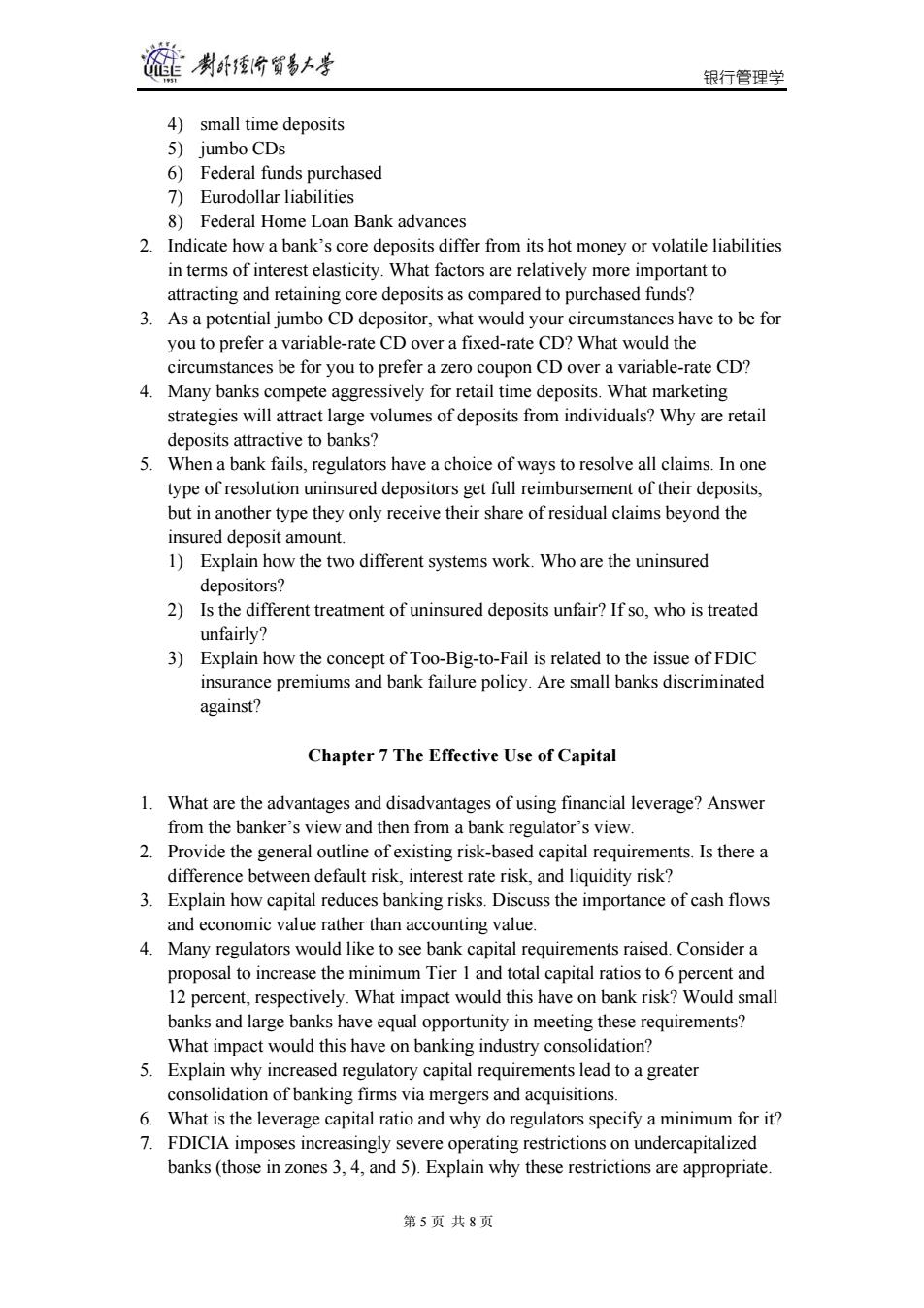正在加载图片...

制卧台贸易上兰 银行管理学 4)small time deposits 5)jumbo CDs 6)Federal funds purchased 7)Eurodollar liabilities 8)Federal Home Loan Bank advances 2.Indicate how a bank's core deposits differ from its hot money or volatile liabilities in terms of interest elasticity.What factors are relatively more important to attracting and retaining core deposits as compared to purchased funds? 3.As a potential jumbo CD depositor,what would your circumstances have to be for you to prefer a variable-rate CD over a fixed-rate CD?What would the circumstances be for you to prefer a zero coupon CD over a variable-rate CD? 4.Many banks compete aggressively for retail time deposits.What marketing strategies will attract large volumes of deposits from individuals?Why are retail deposits attractive to banks? 5.When a bank fails,regulators have a choice of ways to resolve all claims.In one type of resolution uninsured depositors get full reimbursement of their deposits, but in another type they only receive their share of residual claims beyond the insured deposit amount. 1)Explain how the two different systems work.Who are the uninsured depositors? 2)Is the different treatment of uninsured deposits unfair?If so,who is treated unfairly? 3)Explain how the concept of Too-Big-to-Fail is related to the issue of FDIC insurance premiums and bank failure policy.Are small banks discriminated against? Chapter 7 The Effective Use of Capital 1.What are the advantages and disadvantages of using financial leverage?Answer from the banker's view and then from a bank regulator's view. 2.Provide the general outline of existing risk-based capital requirements.Is there a difference between default risk,interest rate risk,and liquidity risk? 3.Explain how capital reduces banking risks.Discuss the importance of cash flows and economic value rather than accounting value. 4.Many regulators would like to see bank capital requirements raised.Consider a proposal to increase the minimum Tier I and total capital ratios to 6 percent and 12 percent,respectively.What impact would this have on bank risk?Would small banks and large banks have equal opportunity in meeting these requirements? What impact would this have on banking industry consolidation? 5.Explain why increased regulatory capital requirements lead to a greater consolidation of banking firms via mergers and acquisitions. 6.What is the leverage capital ratio and why do regulators specify a minimum for it? 7.FDICIA imposes increasingly severe operating restrictions on undercapitalized banks(those in zones 3,4,and 5).Explain why these restrictions are appropriate 第5页共8页银行管理学 第 5 页 共 8 页 4) small time deposits 5) jumbo CDs 6) Federal funds purchased 7) Eurodollar liabilities 8) Federal Home Loan Bank advances 2. Indicate how a bank’s core deposits differ from its hot money or volatile liabilities in terms of interest elasticity. What factors are relatively more important to attracting and retaining core deposits as compared to purchased funds? 3. As a potential jumbo CD depositor, what would your circumstances have to be for you to prefer a variable-rate CD over a fixed-rate CD? What would the circumstances be for you to prefer a zero coupon CD over a variable-rate CD? 4. Many banks compete aggressively for retail time deposits. What marketing strategies will attract large volumes of deposits from individuals? Why are retail deposits attractive to banks? 5. When a bank fails, regulators have a choice of ways to resolve all claims. In one type of resolution uninsured depositors get full reimbursement of their deposits, but in another type they only receive their share of residual claims beyond the insured deposit amount. 1) Explain how the two different systems work. Who are the uninsured depositors? 2) Is the different treatment of uninsured deposits unfair? If so, who is treated unfairly? 3) Explain how the concept of Too-Big-to-Fail is related to the issue of FDIC insurance premiums and bank failure policy. Are small banks discriminated against? MARY Chapter 7 The Effective Use of Capital 1. What are the advantages and disadvantages of using financial leverage? Answer from the banker’s view and then from a bank regulator’s view. 2. Provide the general outline of existing risk-based capital requirements. Is there a difference between default risk, interest rate risk, and liquidity risk? 3. Explain how capital reduces banking risks. Discuss the importance of cash flows and economic value rather than accounting value. 4. Many regulators would like to see bank capital requirements raised. Consider a proposal to increase the minimum Tier 1 and total capital ratios to 6 percent and 12 percent, respectively. What impact would this have on bank risk? Would small banks and large banks have equal opportunity in meeting these requirements? What impact would this have on banking industry consolidation? 5. Explain why increased regulatory capital requirements lead to a greater consolidation of banking firms via mergers and acquisitions. 6. What is the leverage capital ratio and why do regulators specify a minimum for it? 7. FDICIA imposes increasingly severe operating restrictions on undercapitalized banks (those in zones 3, 4, and 5). Explain why these restrictions are appropriate